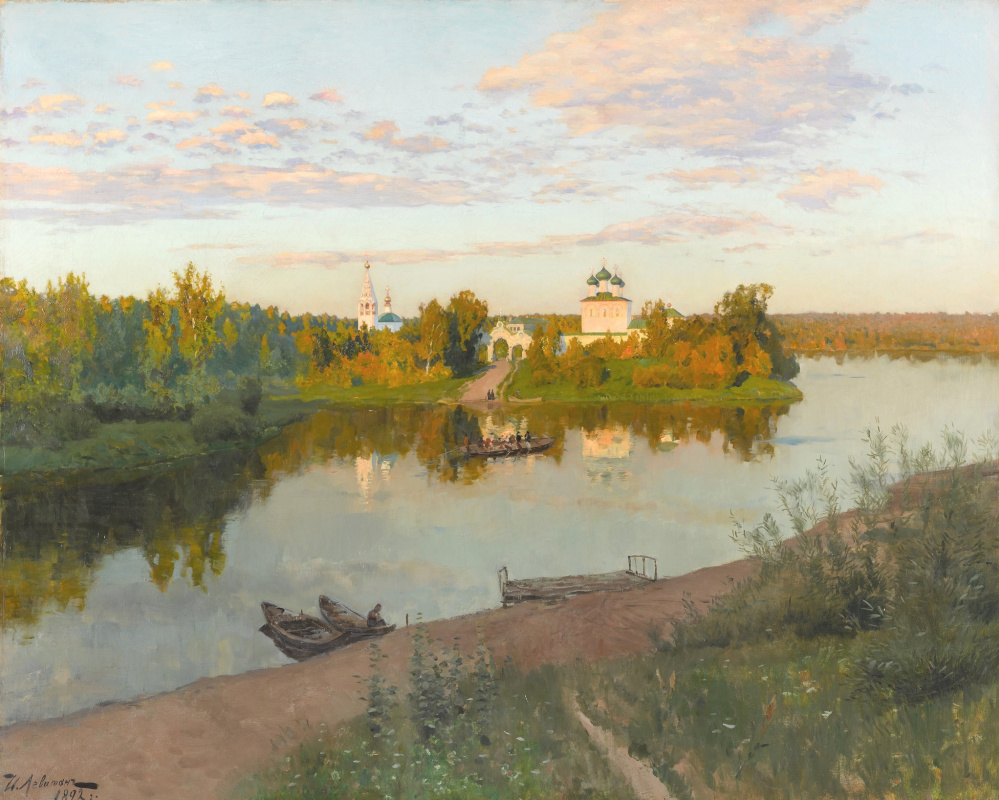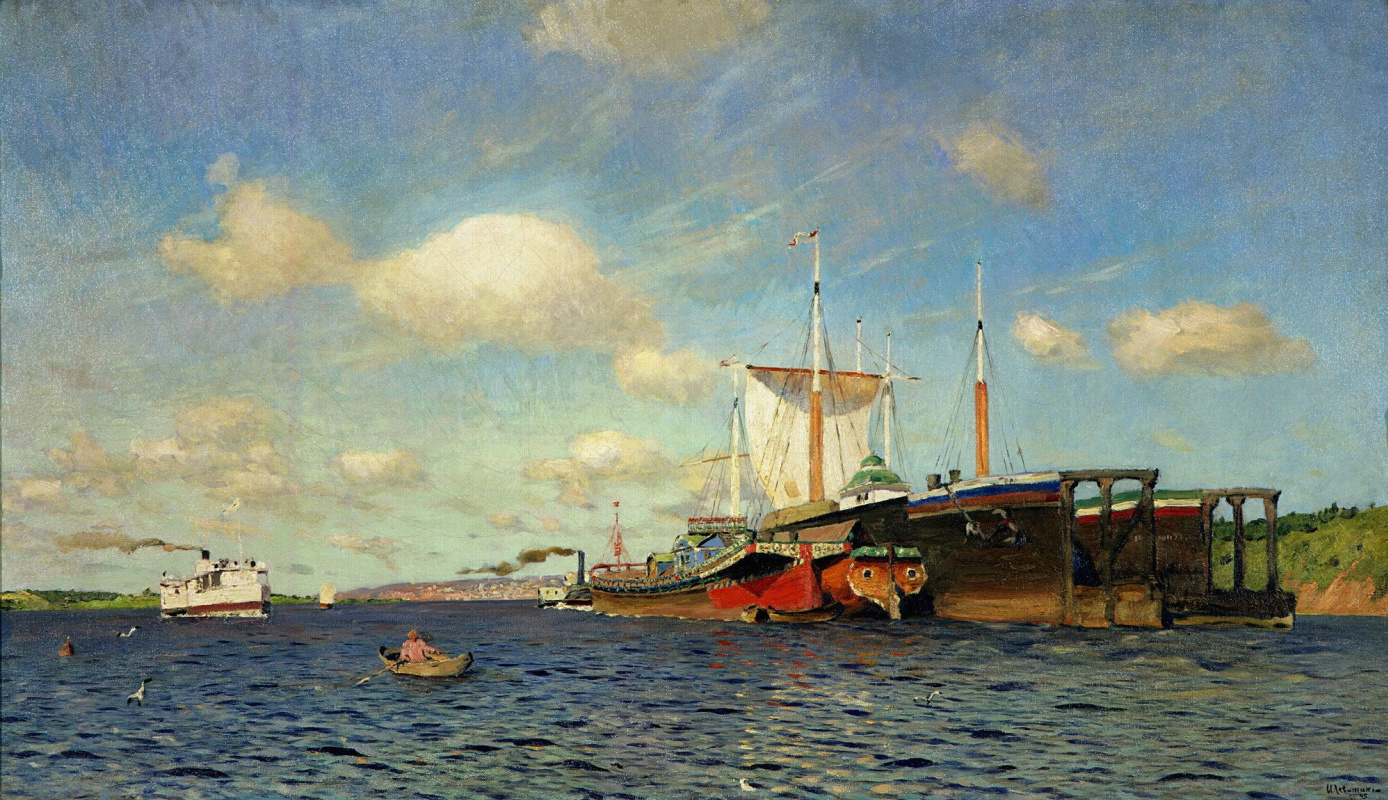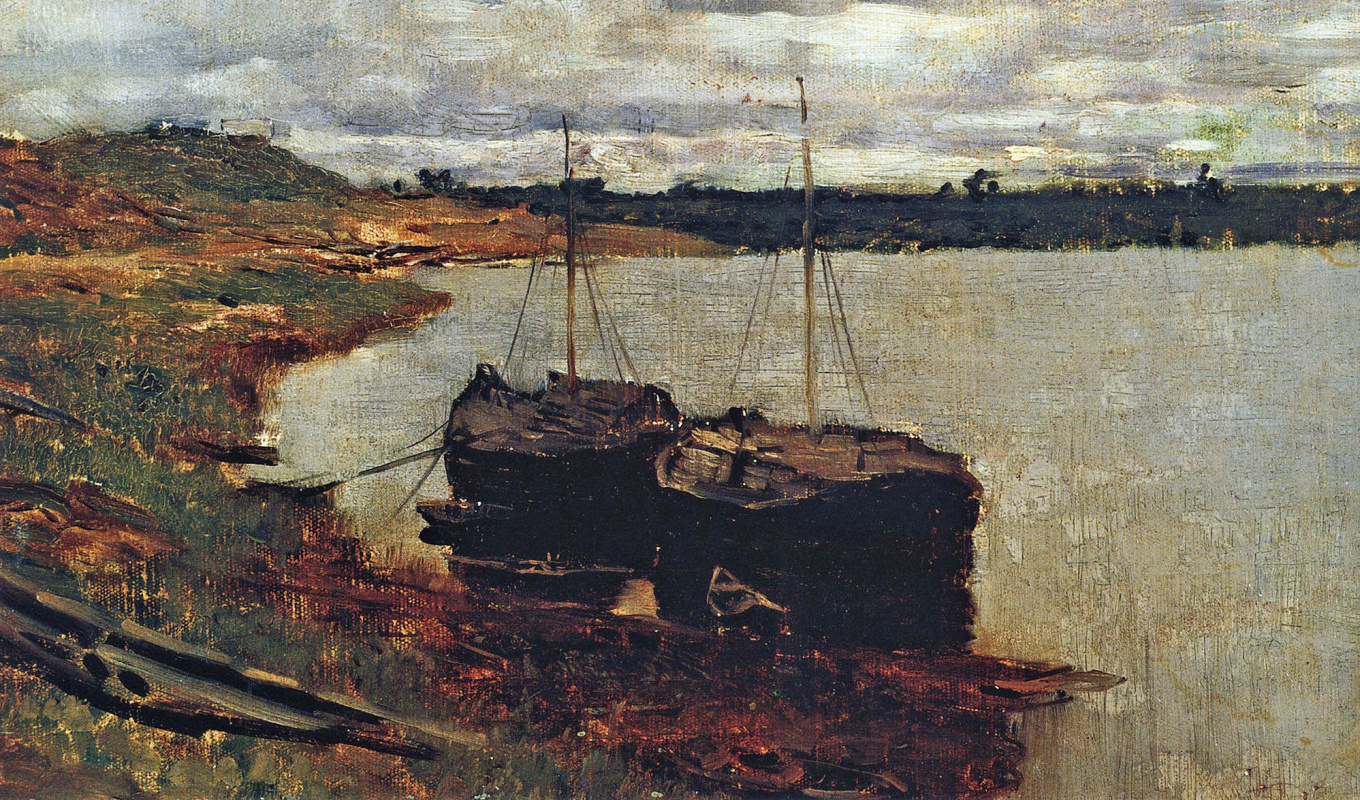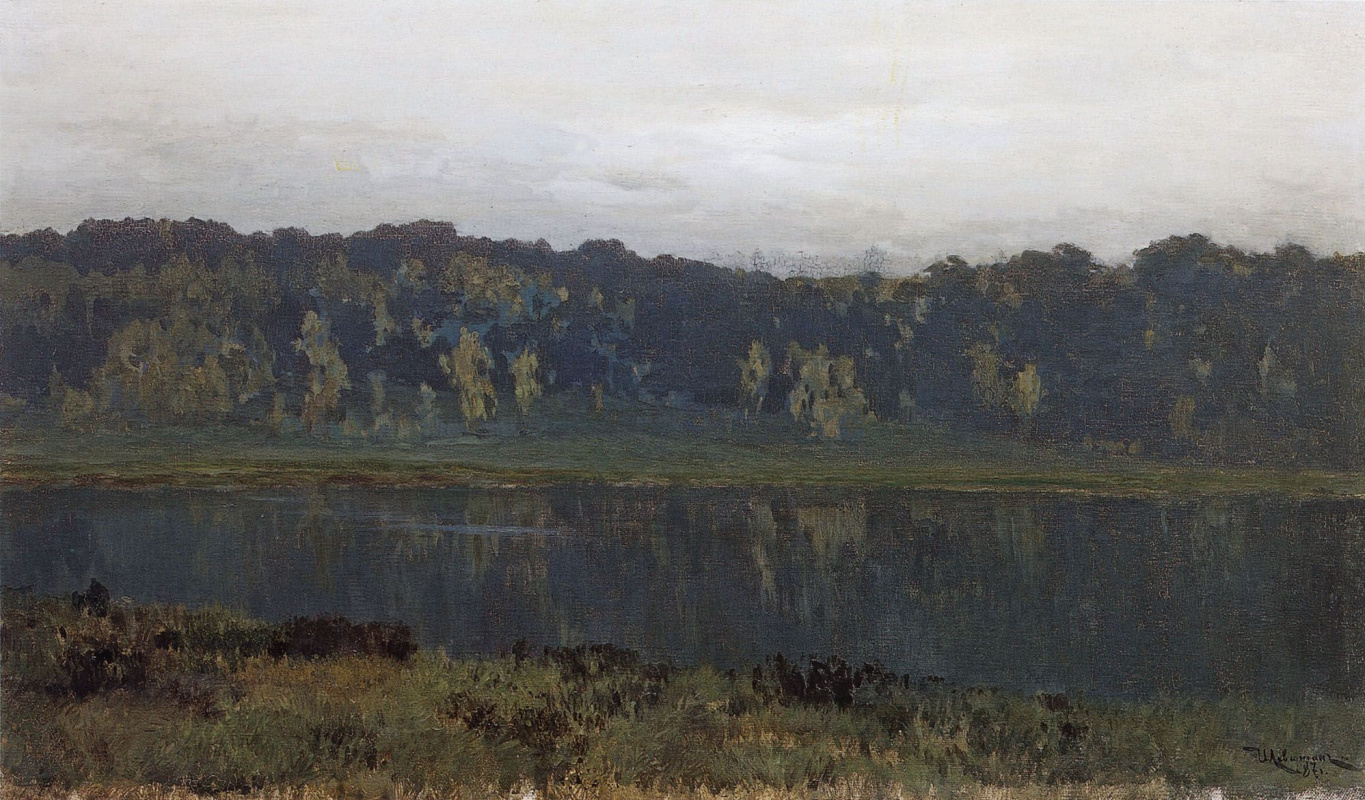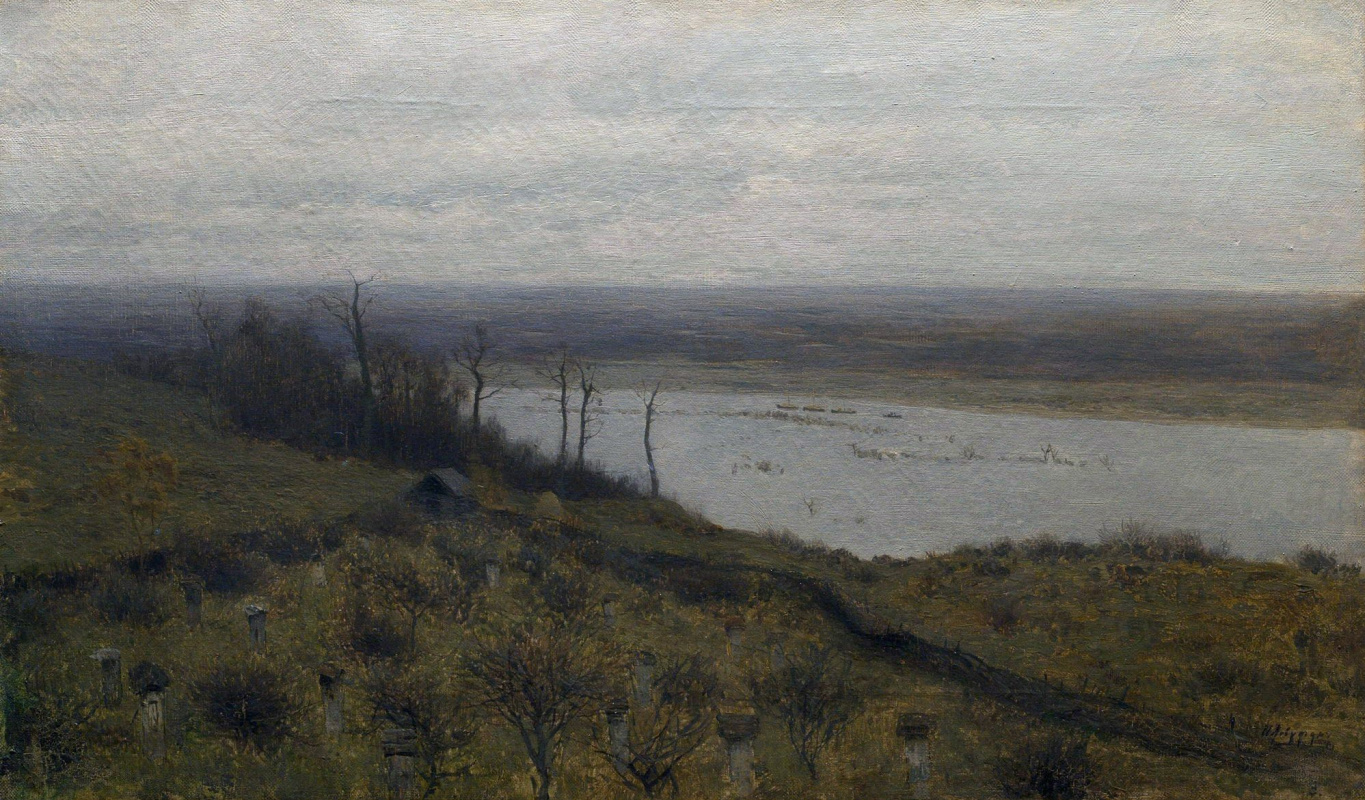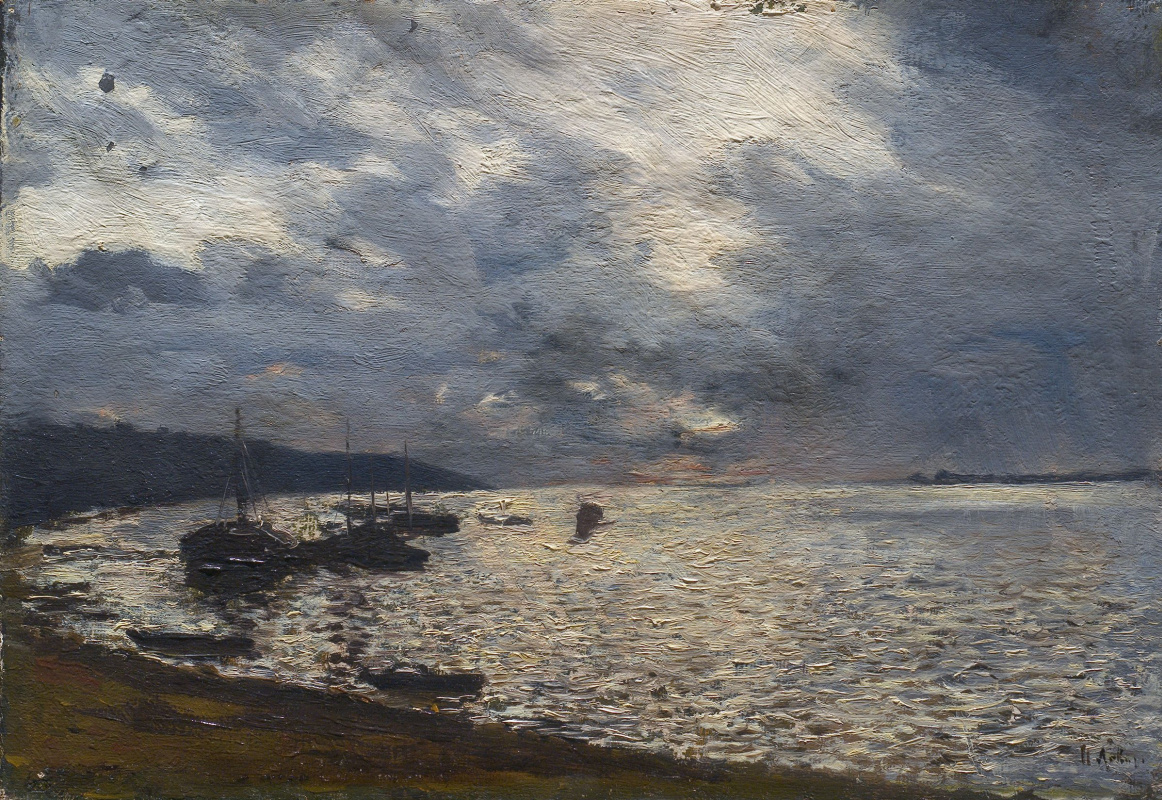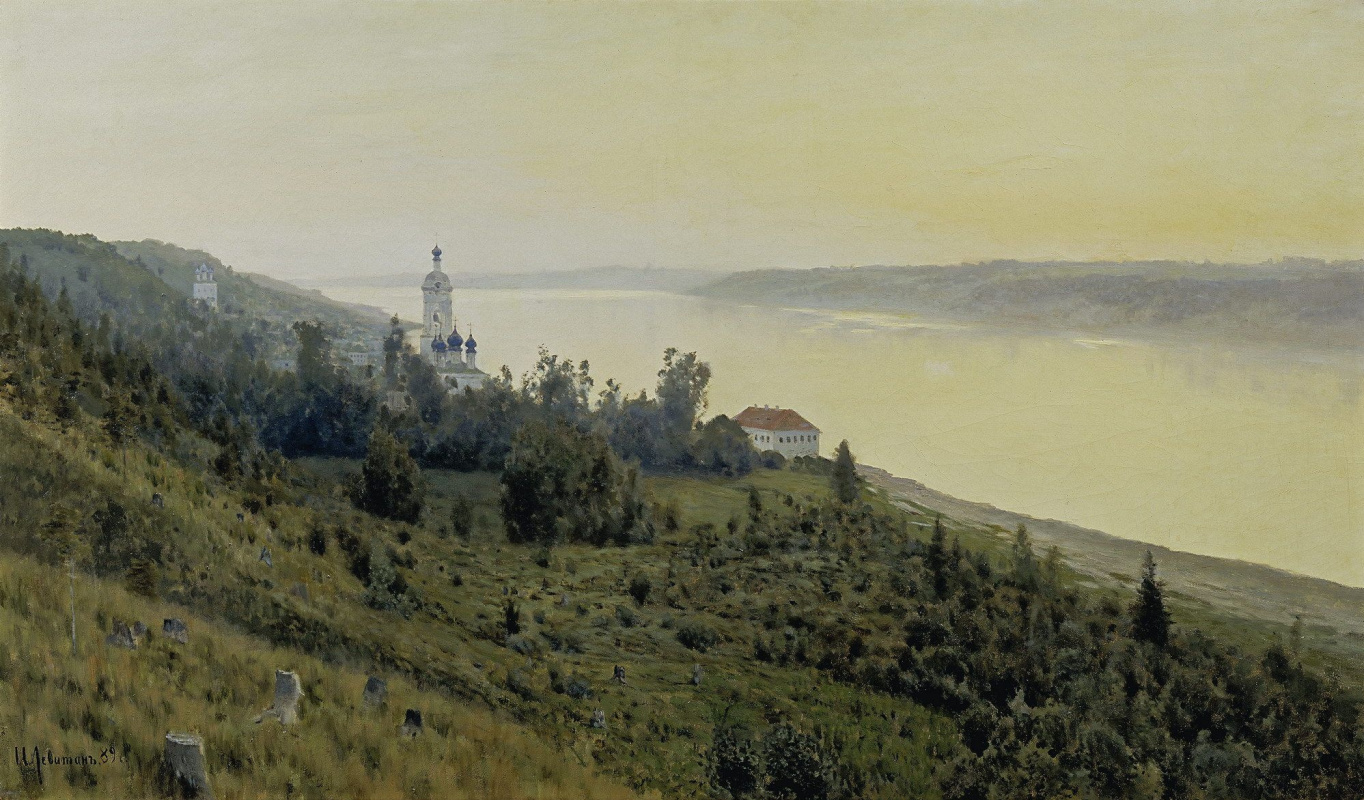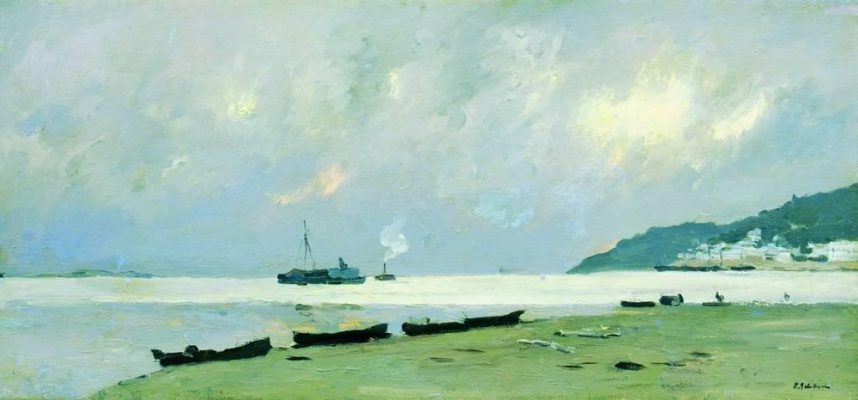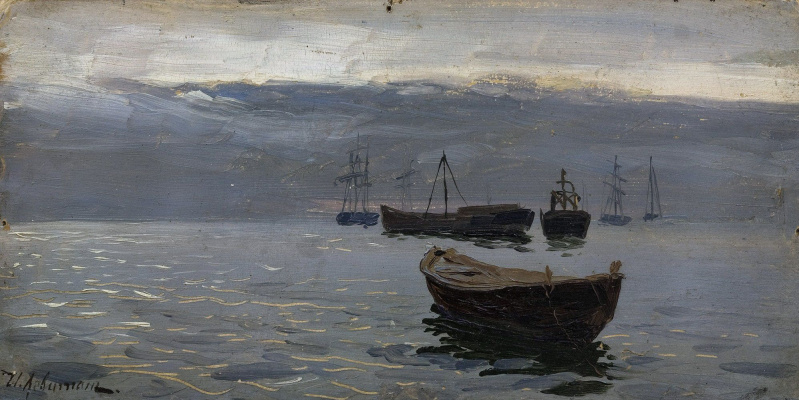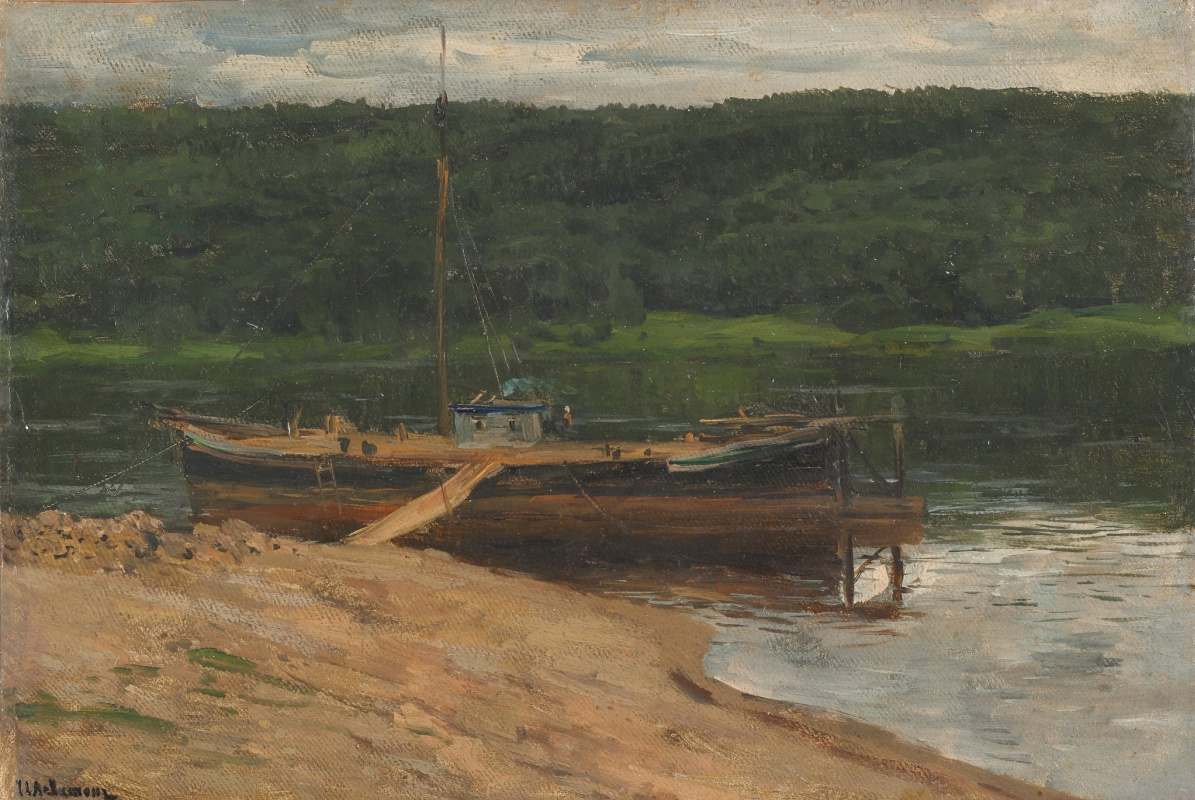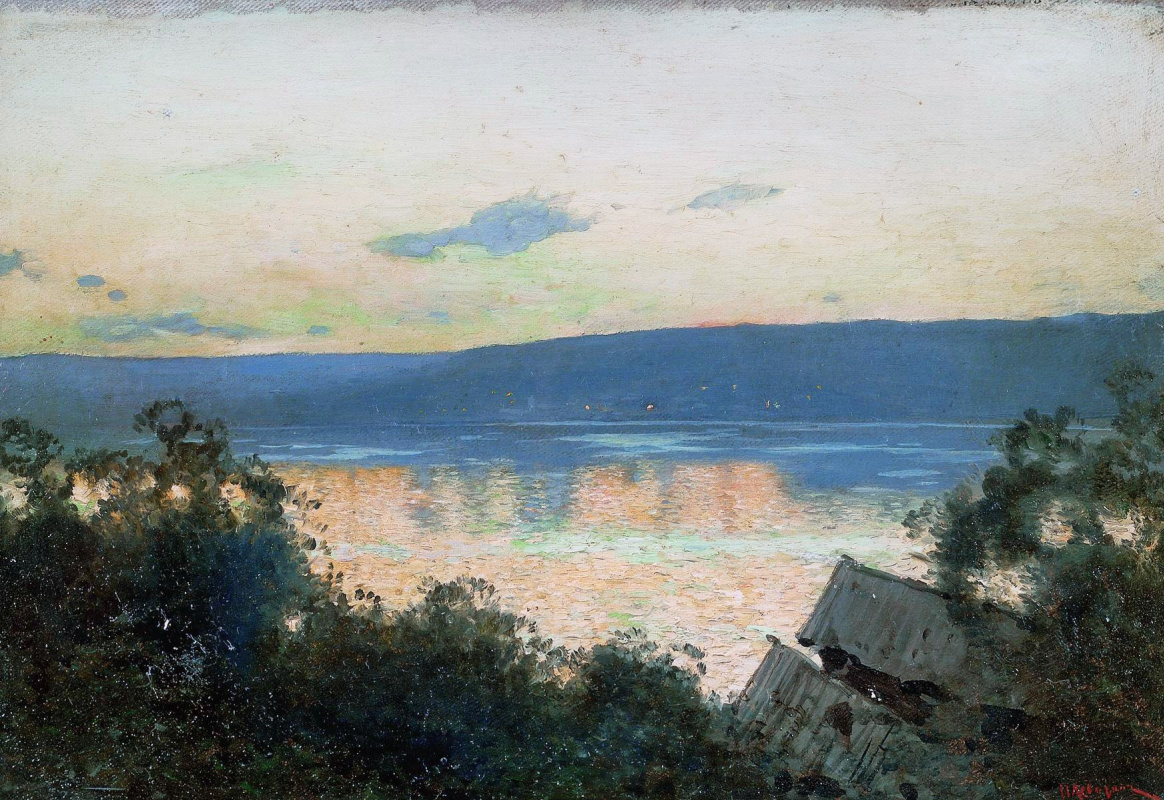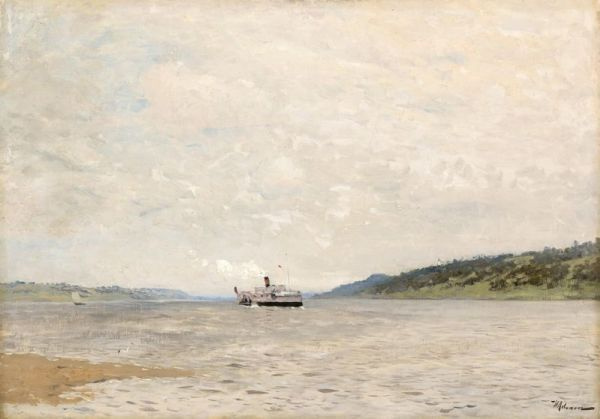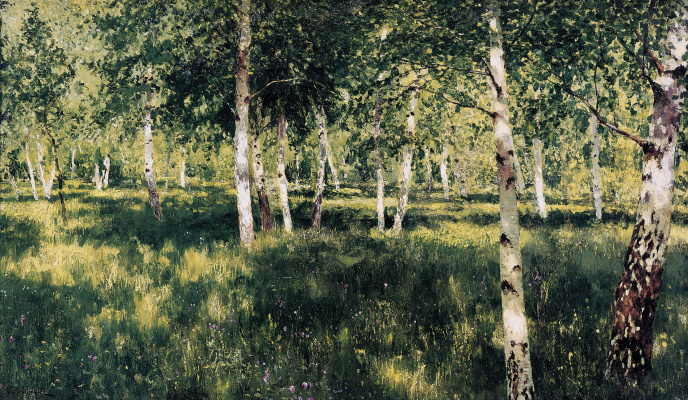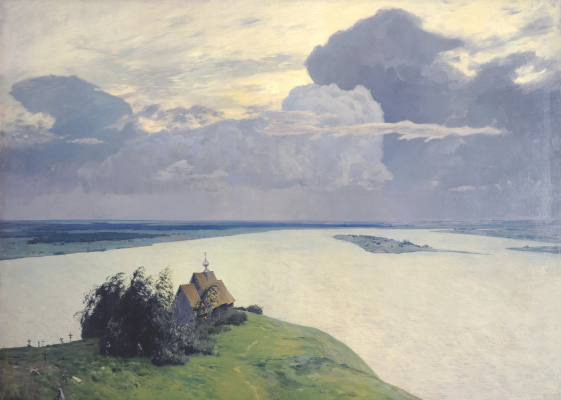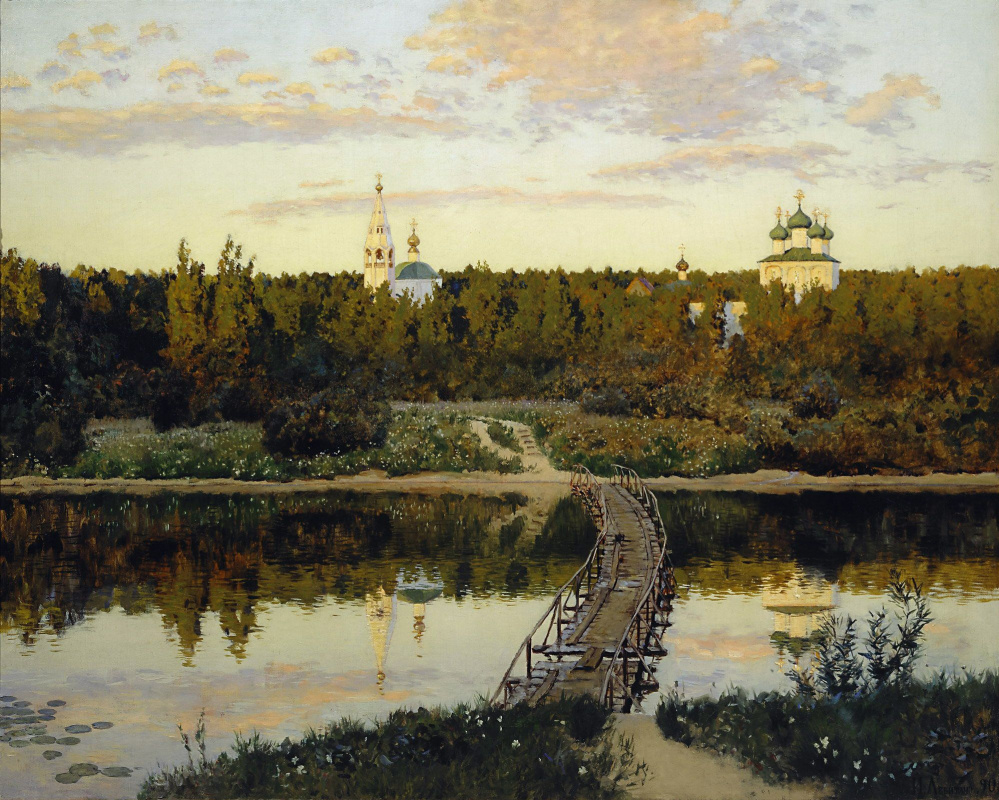The famous paintings of Levitan - “Evening. Golden Reach ”,“ Evening Ringing ”,“ Quiet Convent ”,“ Over Eternal Peace ”- are inspired by the Volga. The warm months of 1887 and the following three years, spent on the Volga shores, became, in Levitan's creative life, perhaps the most significant and fruitful period, put him in the front row of Russian painters. Now it is impossible to imagine Levitan outside of his Volga sketches and paintings: had it not been for the Volga town of Plyos in his life, the love and devotion of Sofia Kuvshinnikova and the Volga, this would probably be a completely different artist.
Evening bells
1892, 87×108 cm
Born on the western edge of the Russian Empire, in the village of Kibarta, near the Verzhbolovo station of the Suvalki province (now it is the territory of Lithuania) and living conscious years of life in Moscow, Isaac Levitan “fell in love” with the never-seen Volga in absentia - thanks to the paintings of his teacher Alexei Savrasov (1, 2, 3, 4, 5) and photographs of the great river, which young Levitan revised hundreds, if not thousands.
The Volga was often dreamed of by the impressionable Levitan. In his imagination there was a “own” fantastic river, and Levitan’s biggest dream was to see the Volga live. When the Moscow School of Painting, Sculpture and Architecture decided to award an orphan student who showed significant success with a trip to the Volga, appointing a special scholarship, the 21-year-old Levitan almost cried from his overwhelming emotions.
But suddenly Teresa, the sister of Levitan, came down, she was suspected of tuberculosis. Not long ago, Isaac was angry at a troublesome sister, who, selling his sketches to wealthy masters, shamelessly praised her brother and bargained with cheerful excitement. It seemed to Levitan: with her obsessive trade, she dishonored his name, and only when two years ago, Teresa, without a shadow of embarrassment, appeared on the threshold of Tretyakovademanding to buy a “picture” of her as yet unknown to anyone, but definitely a genius brother, Pavel Mikhailovich politely sent her away without a penny, Levitan thought that he would never forgive such dishonor. Now danger loomed over her - and Levitan without hesitation gave the money that the school allocated for his trip for the treatment of his sister.
Teresa, fortunately, got better. But the Volga Levitan did not see. His dream was put off for a few more years.
The Volga was often dreamed of by the impressionable Levitan. In his imagination there was a “own” fantastic river, and Levitan’s biggest dream was to see the Volga live. When the Moscow School of Painting, Sculpture and Architecture decided to award an orphan student who showed significant success with a trip to the Volga, appointing a special scholarship, the 21-year-old Levitan almost cried from his overwhelming emotions.
But suddenly Teresa, the sister of Levitan, came down, she was suspected of tuberculosis. Not long ago, Isaac was angry at a troublesome sister, who, selling his sketches to wealthy masters, shamelessly praised her brother and bargained with cheerful excitement. It seemed to Levitan: with her obsessive trade, she dishonored his name, and only when two years ago, Teresa, without a shadow of embarrassment, appeared on the threshold of Tretyakovademanding to buy a “picture” of her as yet unknown to anyone, but definitely a genius brother, Pavel Mikhailovich politely sent her away without a penny, Levitan thought that he would never forgive such dishonor. Now danger loomed over her - and Levitan without hesitation gave the money that the school allocated for his trip for the treatment of his sister.
Teresa, fortunately, got better. But the Volga Levitan did not see. His dream was put off for a few more years.
Fresh wind. Volga
1895, 72×123 cm
The first meeting of Levitan with the Volga turned into a terrible disappointment
In the spring of 1887, instead of the familiar and already well-studied Moscow region, the 27-year-old Levitan first went to studies on the Volga. He looks forward to amazing views that will be remembered for a lifetime, and exciting, inspired work. But in reality, it turned out completely wrong.
Volga met the artist unfriendly.
“I was extremely disappointed - Levitan wrote to Chekhov. - I was waiting for the Volga as a source of strong artistic impressions, and in return for this, it seemed to me so dreary and dead that my heart ached and the thought came to me whether to leave back? And in fact, imagine the following continuous landscape: the right bank, upland, is covered with stunted shrubs and, like lichens, cliffs. Left ... completely flooded forests. And above all this is a gray sky and a strong wind. Well, just death ... I'm sitting and thinking, why did I go? I couldn’t work separately near Moscow and ... not feel lonely and face to face with a huge expanse of water that could simply kill ... Now it started to rain. This was just lacking! .. "
Levitan rented a room with two lonely old women. I wanted to wait for the weather to change. But, as a sin, that year the rains charged in full swing. They knocked tediously on the roof, preventing them from falling asleep at night, and during the day all the time there was a gray drizzle in the air. In the absence of the sun, natural colors “did not sound”, water and banks merged into a continuous and slurred mass. Gray and brown shades absorbed the space. There was almost no way to work in the air: the painful Levitan quickly got wet and cold, the stiffened trembling fingers did not obey him. The clay banks of the Volga, like a sponge, were saturated with water, and there was no way to build an artist’s famous white umbrella in them. Forcedly inactive during the day, Levitan for a long time could not sleep at night and sometimes envied the friendly snoring of his mistresses behind the wall. A well-known longing was approaching - a terrible guest, who more than once put Isaac Levitan on the threshold of life and death.
The writer Konstantin Paustovsky tried to get used to the circumstances of Levitan and convey in words what the artist could feel on his first unsettled Volga trip when the blue dream met a gray reality:
“The dawn was lost in the impenetrable night wastelands, where the inhospitable wind was in charge. Levitan was seized with fear. It seemed to him that the night would last for weeks, that he was exiled to this dirty village and was doomed to listen all his life to the wet branches of birch trees whipping along the log wall. Sometimes he went out on the threshold at night, and branches painfully hit him in the face and hands. Levitan was angry, lit a cigarette, but immediately threw it - sour tobacco smoke drove his jaw.
On the Volga, a stubborn slave knock of steamboat wheels was heard - the tug, blinking yellow lanterns, pulled up, to Rybinsk, smelly barges. The great river seemed to Levitan on the threshold of a gloomy hell ... "
The artist never found contact with the river. There was no special, almost intimate, intimacy necessary for the birth of a lyrical landscape between the landscape and Levitan. The river seemed alien and unreasonably hostile to him. Frustrated and frustrated, he returned to Moscow, confident that he was unlikely to continue to be pulled to the Volga.
But, thinking that the Volga forever “let go” of him, Levitan was mistaken.
Barges. Volga
1889, 17.5×29 cm
Volga from the high Bank
1887, 20×34 cm
Difficult winters and interesting acquaintances
In the cold season Levitan was sad without the sun and stopped going to sketches. In a hotel room or rented apartment, he dismantled the summer outskirts of Moscow and the Volga, selected from the quickest sketches the most “sharp” and characteristic, looked for the best layout, mentally cutting off unnecessary details. So the noble laconicism of Levitan's paintings was born - a quality in which he will have no equal in Russian painting.
In the studio, Levitan "brought to mind" what he started in nature. Surprisingly, the more his skill increased, the more time he needed to finish the picture. In the winter of 1887-88. he again and again returns to the Volga works, adds something, corrects. So there are “Evening on the Volga”, “Spill on the Sura”, “Cloudy day on the Volga”, “Rafts”. These are not just fleeting sketches; in them, especially in the “Evening on the Volga” scale appears. A huge water stream over which dusk is gathering, an alarmingly endless sky and only hints of human presence (like beehives on a sloping hill or wooden boats off the coast) - all this brought a new, epic dimension to Levitan's painting.
Volga works of Levitan receive their first recognition from a luminous artist Vasily Vereshchagin- in 1887, he bought the painting “Autumn Morning. Fog ”for a personal collection.
Autumn morning. Fog
1887, 43×74 cm
Evening on the Volga
1888, 50×81 cm
The spill on the Sur
1887, 45×75.5 cm
Cloudy day on the Volga
1888, 23.3×33 cm
The single blue-green-gray palette of Levitan's early Volga works reflected his own mental state - severe melancholy. Fear of fate, uncertainty in their own calling brought the artist to despair. In 1886, Anton Chekhov, seeing that his friend was yearning more and more (once Levitan, who had planned to take his own life at the peak of depression, managed to take it out of the loop), he decided to entertain him with an interesting acquaintance.
Later, Chekhov will talk about this fateful step to the artist. Mikhail Nesterov: “I have always believed that Levitan longing was the beginning of a mental illness. His inner dramas found expression in the landscape, and his enthusiasm for the landscape led to the birth of new dramas. He could not do otherwise. Even when Tretyakov began to buy his landscapes, even when they started talking about his Crimean sketches as a new breath in painting, he complained of longing. He then nearly committed suicide. As a friend and as a doctor, I wanted to help Levitan and decided to take him to unwind in the Kuvshinnikova’s salon, on Khitrovka, under a fire tower ”.
Khitrovsky market - the famous Moscow “bottom”, the mournful district of Moscow. Near the fire tower there was a police station, where they constantly brought in violent, sometimes drunk, wounded with a knife or bruised in a tavern fight. Police doctor Dmitry Pavlovich Kuvshinnikov had an apartment on the ground floor under a fire tower, in which his wife Sofya Petrovna kept a popular art salon, where artists came to visit - artists, writers, actors. It was fun and interesting. While her husband disappeared at work, Sofya Petrovna played music, painted in oil, invented and sewed unusual costumes and decorated the apartment in the Russian style. In Dmitry Pavlovich Kuvshinnikov, Levitan unexpectedly recognized the boastful "halt hunter" with famous paintingshis teacher Vasily Perov, and Sofya Petrovna, who was a good drawer and sincerely in love with art, agreed to give several painting lessons. She was 39 years old, he was 26. A love affair that did not fit well in the words "adultery" or "affair" would last a long 8 years.
Later, Chekhov will talk about this fateful step to the artist. Mikhail Nesterov: “I have always believed that Levitan longing was the beginning of a mental illness. His inner dramas found expression in the landscape, and his enthusiasm for the landscape led to the birth of new dramas. He could not do otherwise. Even when Tretyakov began to buy his landscapes, even when they started talking about his Crimean sketches as a new breath in painting, he complained of longing. He then nearly committed suicide. As a friend and as a doctor, I wanted to help Levitan and decided to take him to unwind in the Kuvshinnikova’s salon, on Khitrovka, under a fire tower ”.
Khitrovsky market - the famous Moscow “bottom”, the mournful district of Moscow. Near the fire tower there was a police station, where they constantly brought in violent, sometimes drunk, wounded with a knife or bruised in a tavern fight. Police doctor Dmitry Pavlovich Kuvshinnikov had an apartment on the ground floor under a fire tower, in which his wife Sofya Petrovna kept a popular art salon, where artists came to visit - artists, writers, actors. It was fun and interesting. While her husband disappeared at work, Sofya Petrovna played music, painted in oil, invented and sewed unusual costumes and decorated the apartment in the Russian style. In Dmitry Pavlovich Kuvshinnikov, Levitan unexpectedly recognized the boastful "halt hunter" with famous paintingshis teacher Vasily Perov, and Sofya Petrovna, who was a good drawer and sincerely in love with art, agreed to give several painting lessons. She was 39 years old, he was 26. A love affair that did not fit well in the words "adultery" or "affair" would last a long 8 years.
“Other” Volga and Ples
In the spring of 1888, Sofya Petrovna convinced Levitan to go to the Volga again. Two summers before that, they went to sketches in the Savvinskaya Sloboda near Zvenigorod, and these places managed to get bored with Kuvshinnikova. Levitan did not agree for a long time: “To the Volga? Yes, drop it! I've already been there ”. It seemed that he was frightened by the prospect again, like two years ago, of being face to face with a gloomy river. The doctor and friend would gladly agree with him. “Levitan cannot live on the Volga, - Chekhov explained, - it puts gloom on the soul. "
Then the resourceful Sophia, who became a “living sedative” for the nervous Levitan, proposed an alternative - Oka. Together with their mutual friend-artist Alexey Stepanovthey drove to Ryazan in a cab and then sailed on a boat along the Oka. They stuck near the village of Chulkovo and decided that they would stop there. We took out easels, put up umbrellas, and began to draw. But then around them people began to gather and in the air "smelled of electricity." “They looked at us as some kind of Aztecs”- later writes in memoirs Sofya Petrovna. The Chulkovites were outraged that some newcomers had come to them without invitation, for some reason they were copying their houses and the mill, it is unclear what they had in mind. Some stupid young woman voted: “Dashing people have arrived!"Just a little bit - and stones would have flown into travelers. They had to take off and retire. On the Oka they reached the Lower, and from there sailed along the Volga, wondering where to stick to them. They intuitively looked for places where everyone would be happy - they worked and lived. Having rejected several Volga cities, they saw Ples from the steamer.
"He immediately fascinated us, - wrote Kuvshinnikova, - and we decided to stop. What attracted us most of all was that little ancient church, which other artists also began to write more than once, and indeed the town turned out to be a premium corner, surprisingly beautiful, poetic and quiet. We found two rooms near the shore, and with the help of hay, carpets, two tables and several benches, we arranged a bivouac. The reckless life of our bohemia, of course, made a strong impression here too. The artist here was an unprecedented bird. Asked and talked: who? as? what for? why? At the bazaar all the news was reported about us: what we eat, where we go, etc. But somehow it soon subsided. They quickly got used to us, and we got used to it. ”
Levitan ancient Ples charmed. Birch groves, small temples and picturesque Volga slopes now seemed to him filled with humble and touching beauty. He stopped moping and set to work, started 5-6 paintings at once, worked quickly, enthusiastically, with binges. The charm of the Volga and Plyos miraculously transformed the mood of Levitan. Now he did not trust his own recollections: is this magnificent, calm beautiful river really the one that he did not understand and did not accept on his last visit — weeping, ugly, stern?
About the new Volga paintings, when the author shows them in Moscow, the insightful Chekhov will say to Levitan: “You know, but a smile appeared in them”.
Evening. Golden Plyos
1889, 84×142 cm
After the rain. Ples
1889, 80×125 cm
To get up in Plyos Levitan was addicted very, very early so as not to miss the first sundial when steam rises above the Volga. Sofya Petrovna woke up and ran after him with warm clothes, so that he would not chill, but would return to inspect dreams herself. Toward noon, she joined Levitan, placed her next to his white canvas umbrella, and opened the sketchbook. She was not only a caring lover, but also a diligent student: the painting by Kuvshinnikova “Inside the Peter and Paul Church in Plyos” was acquired by Tretyakov.
In the city there was an abandoned church in which no one served for several decades, fearing the collapse of the roof. The mysterious ancient temple shook the artistic imagination of Kuvshinnikova and Levitan. They were not too lazy to find the decrepit freelance priest who had once served in this parish, and persuade him to unlock the church and even serve the liturgy there. At the same time, Levitan asked in a whisper where to put candles, what kind of saints they looked at them from the icons, and to tears he was touched by singing, and the priest was silently amazed at the strange parishioner. How much the decoration of the church impressed Levitan can be judged by the fact that he, quite indifferent to architecture and everything man-made, painted the interior of the Peter and Paul Church in Plyos.
In the city there was an abandoned church in which no one served for several decades, fearing the collapse of the roof. The mysterious ancient temple shook the artistic imagination of Kuvshinnikova and Levitan. They were not too lazy to find the decrepit freelance priest who had once served in this parish, and persuade him to unlock the church and even serve the liturgy there. At the same time, Levitan asked in a whisper where to put candles, what kind of saints they looked at them from the icons, and to tears he was touched by singing, and the priest was silently amazed at the strange parishioner. How much the decoration of the church impressed Levitan can be judged by the fact that he, quite indifferent to architecture and everything man-made, painted the interior of the Peter and Paul Church in Plyos.
Inside the Peter and Paul Church in Plyos, on the Volga
1888, 14.3×25.2 cm
Once on the Volga, Levitan experienced a real existential horror: bees attacked his white umbrella, carefully soaked in blue, so as not to let in the sun's rays. A giant swarm of insects that had left their previous home with a buzz descended to the surface of the umbrella. The white light has darkened. Levitan did not move and held his breath. Pierce him at once, these hundreds of stings - and that’s it, the end. But the bees starred and flew on.
People were more insistent. They stared at Levitan, preventing him from working. Previously, he often ran away from people, hid, disappeared for several days in the forest with the dog Vesta, but did not hunt, but wandered around without a goal, trying to regain his lost emotional balance. But in Plyos, almost nothing irritated him - on the contrary, everything seemed inexplicably attractive, located towards him and kind.
Sometime around noon, Levitan perched right by the road under his umbrella. An old praying mantis walked past him. Apparently, in the nearest village, the mass was recently over and she hurried home, but for some reason hesitated, peered at Levitan and what he was writing, and shaking her head softly. It is not known what came to her mind and who Levitan thought to her, but the old woman took a coin from her purse and threw it into the paint box. Levitan thankfully kept this coin and carried it everywhere with him like a talisman.
People were more insistent. They stared at Levitan, preventing him from working. Previously, he often ran away from people, hid, disappeared for several days in the forest with the dog Vesta, but did not hunt, but wandered around without a goal, trying to regain his lost emotional balance. But in Plyos, almost nothing irritated him - on the contrary, everything seemed inexplicably attractive, located towards him and kind.
Sometime around noon, Levitan perched right by the road under his umbrella. An old praying mantis walked past him. Apparently, in the nearest village, the mass was recently over and she hurried home, but for some reason hesitated, peered at Levitan and what he was writing, and shaking her head softly. It is not known what came to her mind and who Levitan thought to her, but the old woman took a coin from her purse and threw it into the paint box. Levitan thankfully kept this coin and carried it everywhere with him like a talisman.
Kuvshinnikova and Levitan walked a dozen kilometers a day, climbed into the most remote corners, and found the rarest and most beautiful landscapes. When tired of painting - went on a hunt. Sophia hunted no less recklessly than Levitan, could spend hours tracking down the game, and even outstripping him with endurance: even then, Levitan’s heart started to play pranks. They competed in the amount of game shot and even quarreled over this.
For three years in a row Levitan and Sofya Kuvshinnikova came to Plyos. Levitan proceeded with heavy picturesque accessories along the Volga coast along and across. He wrote to Chekhov that he was drawn to stick an umbrella "Every five steps". All corners of these Volga places, all slopes and copses, grasses and trees, water and sunsets, boats and longboats, as Chekhov once said about Babkin’s landscapes, "Shouted and demanded that they be written by Levitan".
For three years in a row Levitan and Sofya Kuvshinnikova came to Plyos. Levitan proceeded with heavy picturesque accessories along the Volga coast along and across. He wrote to Chekhov that he was drawn to stick an umbrella "Every five steps". All corners of these Volga places, all slopes and copses, grasses and trees, water and sunsets, boats and longboats, as Chekhov once said about Babkin’s landscapes, "Shouted and demanded that they be written by Levitan".
On The Volga River. The evening
1888, 8×17 cm
Evening on the Volga
1888, 22×33 cm
Dampfer an der Wolga
1880-er

Rare photo: Isaac Levitan (third from left) in Plyos on the Volga.
"Plyos discovered Levitan"- said the experts. Even in the paintings written in other places, Plyos’s influence affected: Levitan began his most impressive painting “The Birch Grove” in Babkin, near Moscow, but he could finish it only four years later, “watching” how the leaves of the birch grove are excited on the outskirts of Plyos, and the famous painting "Above Eternal Peace", created on Lake Udomlya, Levitan entered the Plesian church.
"Plyos discovered Levitan"- said the experts. Even in the paintings written in other places, Plyos’s influence affected: Levitan began his most impressive painting “The Birch Grove” in Babkin, near Moscow, but he could finish it only four years later, “watching” how the leaves of the birch grove are excited on the outskirts of Plyos, and the famous painting "Above Eternal Peace", created on Lake Udomlya, Levitan entered the Plesian church.
The biggest success came to Levitan in 1891, when at the Traveling Exhibition he presented the "Quiet Convent" - a kind of result of his Volga impressions from visiting Plyos, Yuryevets, Kineshma. “His painting makes a splash”, - Chekhov wrote about Levitan. Alexandre Benois clarified: “He exhibited before, and even several years, but then did not differ from our other landscape painters, from their general, gray and sluggish mass. The appearance of the "Quiet Convent" made, on the contrary, a surprisingly vivid impression. It seemed as though the shutters had been removed from the windows, as if they were wide open, and a stream of fresh, fragrant air gushed into the stained exhibition hall, where it smelled so foul of the excessive amount of sheepskin coats and oiled boots. ".
The “real” Levitan, the creator of the Russian national landscape, begins with the Volga paintings. The Volga from Levitan youthful dreams finally coincided with the Volga in reality.
The “real” Levitan, the creator of the Russian national landscape, begins with the Volga paintings. The Volga from Levitan youthful dreams finally coincided with the Volga in reality.
Ruhige Unterkunft
1890, 87×108 cm
Author: Anna Yesterday


